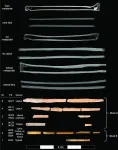(Press-News.org) Contrary to widespread concerns that global crop yields have stagnated in recent decades, a comprehensive study of worldwide food production finds yields have continued to grow at roughly the same rate since the 1960s. John Baffes of the World Bank and Xiaoli Etienne of the University of Idaho, U.S., report these findings on November 27, 2024, in the open-access journal PLOS ONE.
Almost 10 billion people are expected to inhabit Earth by 2050, so agricultural production will become increasingly critical to feeding the growing population. Over the past six decades, much of the growth in food production has stemmed from technological advances, including the widespread development and use of better crop varieties. But some studies have suggested that the growth in production has leveled off, raising concerns about future food availability, especially in the low- and middle-income countries with the highest population growth.
In the new study, the researchers developed standardized measures for production and yield for 144 crops, covering 98 percent of global agricultural land. These measures allow scientists and policymakers to compare agricultural productivity across different countries and regions. The researchers found that there has been no discernable slowdown in the global growth of crop yields during the last six decades – any observed slowdown in specific crops, regions or countries has been offset by gains in others. Their findings show that yields grew annually at a rate equivalent to about 33 kg of wheat per hectare.
While the study’s findings are reassuring from a global food supply perspective, the researchers caution that sustainable food production and the affordability of food will continue to be challenges to global food security. They emphasize that these concerns are particularly relevant in the face of intensifying climate change and increased demand for food due to population and income growth.
The authors add: “Utilizing a comprehensive caloric-based index of production and yield for 144 crops, covering 98% of global agricultural land and food output, this paper reveals that, on an aggregate level, global yield growth—a vital indicator of agricultural productivity—has not slowed over the past six decades. This steady growth equates to an annual increase of approximately 33 kilograms of wheat per hectare, highlighting continued productivity gains worldwide.”
#####
In your coverage please use this URL to provide access to the freely available article in PLOS ONE: https://journals.plos.org/plosone/article?id=10.1371/journal.pone.0313088
Citation: Baffes J, Etienne X (2024) Yield growth patterns of food commodities: Insights and challenges. PLoS ONE 19(11): e0313088. https://doi.org/10.1371/journal.pone.0313088
Author Countries: U.S.A.
Funding: The author(s) received no specific funding for this work.
END
Global food yields have grown steadily during last six decades
But, future food security under population growth will require sustainability and affordability
2024-11-27
ELSE PRESS RELEASES FROM THIS DATE:
Children who grow up with pets or on farms may develop allergies at lower rates because their gut microbiome develops with more anaerobic commensals, per fecal analysis in small cohort study
2024-11-27
Children who grow up with pets or on farms may develop allergies at lower rates because their gut microbiome develops with more anaerobic commensals, per fecal analysis in small cohort study
###
Article URL: https://journals.plos.org/plosone/article?id=10.1371/journal.pone.0313078
Article Title: Gut microbiota markers in early childhood are linked to farm living, pets in household and allergy
Author Countries: Sweden
Funding: This work was supported by the Region Västra Götaland (agreement concerning medical research and education – ALF), https://www.alfvastragotaland.se [ALFGBG966243] [ALFGBG720181] ...
North American Early Paleoindians almost 13,000 years ago used the bones of canids, felids, and hares to create needles in modern-day Wyoming, potentially to make the tailored fur garments which enabl
2024-11-27
North American Early Paleoindians almost 13,000 years ago used the bones of canids, felids, and hares to create needles in modern-day Wyoming, potentially to make the tailored fur garments which enabled their dispersal into these colder climates
###
Article URL: https://journals.plos.org/plosone/article?id=10.1371/journal.pone.0313610
Article Title: Early Paleoindian use of canids, felids, and hares for bone needle production at the La Prele site, Wyoming, USA
Contact: Spencer Pelton, spencer.pelton@wyo.gov, Ph. +1 307 399 2827
Author Countries: U.S.
Funding: Funding for this project includes the National Science Foundation (award #1947297), the ...
Higher levels of democracy and lower levels of corruption are associated with more doctors, independent of healthcare spending, per cross-sectional study of 134 countries
2024-11-27
Higher levels of democracy and lower levels of corruption are associated with more doctors, independent of healthcare spending, per cross-sectional study of 134 countries.
###
Article URL: https://journals.plos.org/globalpublichealth/article?id=10.1371/journal. pgph.0003656
Article Title: The relationship between democracy and corruption and the global physician workforce
Author Countries: Canada
Funding: The authors received no specific funding for this work. END ...
In major materials breakthrough, UVA team solves a nearly 200-year-old challenge in polymers
2024-11-27
Researchers at the University of Virginia School of Engineering and Applied Science have developed a new polymer design that appears to rewrite the textbook on polymer engineering. No longer is it dogma that the stiffer a polymeric material is, the less stretchable it has to be.
“We are addressing a fundamental challenge that has been thought to be impossible to solve since the invention of vulcanized rubber in 1839,” said Liheng Cai, an assistant professor of materials science and engineering, and chemical engineering.
That’s when Charles Goodyear accidentally discovered that heating natural rubber with sulfur ...
Wyoming research shows early North Americans made needles from fur-bearers
2024-11-27
A Wyoming archaeological site where people killed or scavenged a Columbian mammoth nearly 13,000 years ago has produced yet another discovery that sheds light on the life of these early inhabitants of North America.
Wyoming State Archaeologist Spencer Pelton and colleagues at the University of Wyoming and other institutions have found that these Paleolithic humans made needles from the bones of fur-bearers -- including foxes; hares or rabbits; and cats such as bobcats, mountain lions, lynx and possibly even the now-extinct ...
Preclinical tests show mRNA-based treatments effective for blinding condition
2024-11-27
A new preclinical study by Mass Eye and Ear investigators showed that a novel mRNA-based therapy may be able to prevent blindness and scarring from proliferative vitreoretinopathy (PVR) following a retinal detachment repair or traumatic injury to the eye. There is no current treatment for PVR other than surgery, which itself carries a high risk of causing or exacerbating PVR. Their results, published in Science Translational Medicine, show the promise that mRNA-based therapies may one day offer patients with PVR and other retinal conditions.
“This ...
Velcro DNA helps build nanorobotic Meccano
2024-11-27
Researchers at the University of Sydney Nano Institute have made a significant advance in the field of molecular robotics by developing custom-designed and programmable nanostructures using DNA origami.
This innovative approach has potential across a range of applications, from targeted drug delivery systems to responsive materials and energy-efficient optical signal processing. The method uses ‘DNA origami’, so-called as it uses the natural folding power of DNA, the building blocks of human life, to create new and useful biological structures.
As a proof-of-concept, the researchers made more than 50 nanoscale objects, including a ‘nano-dinosaur’, ...
Oceans emit sulfur and cool the climate more than previously thought
2024-11-27
Researchers have quantified for the first time the global emissions of a sulfur gas produced by marine life, revealing it cools the climate more than previously thought, especially over the Southern Ocean.
The study, published in the journal Science Advances, shows that the oceans not only capture and redistribute the sun's heat, but produce gases that make particles with immediate climatic effects, for example through the brightening of clouds that reflect this heat.
It broadens the climatic impact of marine sulfur because it adds a new compound, methanethiol, that had previously gone unnoticed. Researchers only detected the gas recently, because ...
Nanorobot hand made of DNA grabs viruses for diagnostics and blocks cell entry
2024-11-27
CHAMPAIGN, Ill. — A tiny, four-fingered “hand” folded from a single piece of DNA can pick up the virus that causes COVID-19 for highly sensitive rapid detection and can even block viral particles from entering cells to infect them, University of Illinois Urbana-Champaign researchers report. Dubbed the NanoGripper, the nanorobotic hand also could be programmed to interact with other viruses or to recognize cell surface markers for targeted drug delivery, such as for cancer treatment.
Led by Xing Wang, a professor of bioengineering and of chemistry at the ...
Rare, mysterious brain malformations in children linked to protein misfolding, study finds
2024-11-27
In 1992, Judith Frydman, PhD, discovered a molecular complex with an essential purpose in all of our cells: folding proteins correctly.
The complex, a type of “protein chaperone” known as TRiC, helps fold thousands of human proteins: It was later found that about 10% of all our proteins pass through its barrel structure.
All animals have several different kinds of protein chaperones, each with its own job of helping fold proteins in the cell. TRiC binds to newborn proteins and shapes these strings of amino acids into the correct 3D structures, ...
LAST 30 PRESS RELEASES:
Decoupling the HOR enhancement on PtRu: Dynamically matching interfacial water to reaction coordinates
Sulfur isn’t poisonous when it synergistically acts with phosphine in olefins hydroformylation
URI researchers uncover molecular mechanisms behind speciation in corals
Chitin based carbon aerogel offers a cleaner way to store thermal energy
Tracing hidden sources of nitrate pollution in rapidly changing rural urban landscapes
Viruses on plastic pollution may quietly accelerate the spread of antibiotic resistance
Three UH Rainbow Babies & Children’s faculty elected to prestigious American Pediatric Society
Tunnel resilience models unveiled to aid post-earthquake recovery
Satellite communication systems: the future of 5G/6G connectivity
Space computing power networks: a new frontier for satellite technologies
Experiments advance potential of protein that makes hydrogen sulfide as a therapeutic target for Alzheimer’s disease
Examining private equity’s role in fertility care
Current Molecular Pharmacology achieves a landmark: real-time CiteScore advances to 7.2
Skeletal muscle epigenetic clocks developed using postmortem tissue from an Asian population
Estimating unemployment rates with social media data
Climate policies can backfire by eroding “green” values, study finds
Too much screen time too soon? A*STAR study links infant screen exposure to brain changes and teen anxiety
Global psychiatry mourns Professor Dan Stein, visionary who transformed mental health science across Africa and beyond
KIST develops eco-friendly palladium recovery technology to safeguard resource security
Statins significantly reduce mortality risk for adults with diabetes, regardless of cardiovascular risk
Brain immune cells may drive more damage in females than males with Alzheimer’s
Evidence-based recommendations empower clinicians to manage epilepsy in pregnancy
Fungus turns bark beetles’ defenses against them
There are new antivirals being tested for herpesviruses. Scientists now know how they work
CDI scientist, colleagues author review of global burden of fungus Candida auris
How does stroke influence speech comprehension?
B cells transiently unlock their plasticity, risking lymphoma development
Advanced AI dodel predicts spoken language outcomes in deaf children after cochlear implants
Multimodal imaging-based cerebral blood flow prediction model development in simulated microgravity
Accelerated streaming subgraph matching framework is faster, more robust, and scalable
[Press-News.org] Global food yields have grown steadily during last six decadesBut, future food security under population growth will require sustainability and affordability










